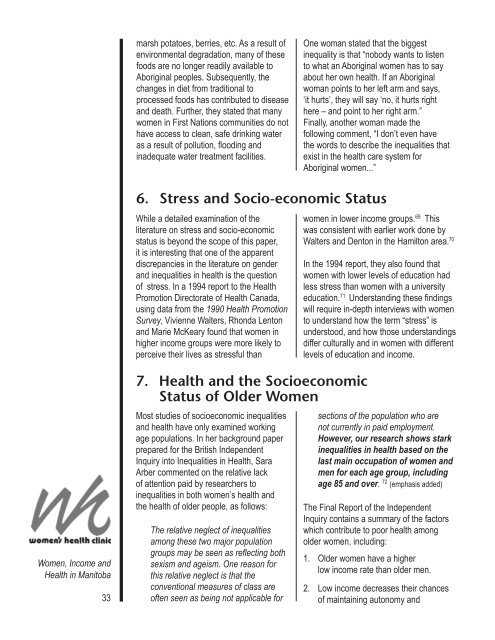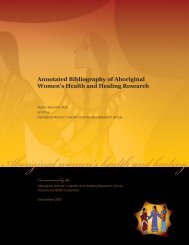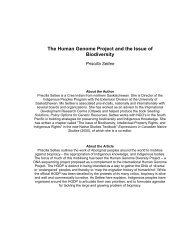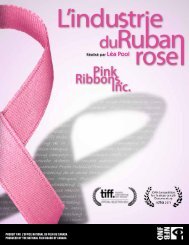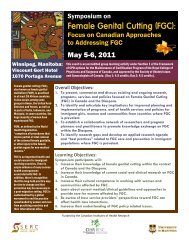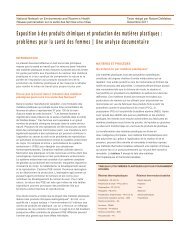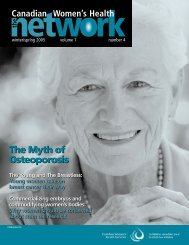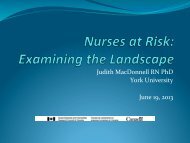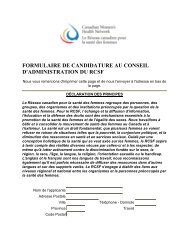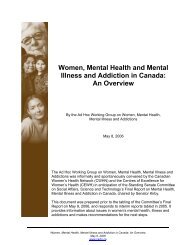here. - Canadian Women's Health Network
here. - Canadian Women's Health Network
here. - Canadian Women's Health Network
- No tags were found...
You also want an ePaper? Increase the reach of your titles
YUMPU automatically turns print PDFs into web optimized ePapers that Google loves.
marsh potatoes, berries, etc. As a result ofenvironmental degradation, many of thesefoods are no longer readily available toAboriginal peoples. Subsequently, thechanges in diet from traditional toprocessed foods has contributed to diseaseand death. Further, they stated that manywomen in First Nations communities do nothave access to clean, safe drinking wateras a result of pollution, flooding andinadequate water treatment facilities.One woman stated that the biggestinequality is that “nobody wants to listento what an Aboriginal women has to sayabout her own health. If an Aboriginalwoman points to her left arm and says,‘it hurts’, they will say ‘no, it hurts right<strong>here</strong> – and point to her right arm.”Finally, another woman made thefollowing comment, “I don’t even havethe words to describe the inequalities thatexist in the health care system forAboriginal women...”6. Stress and Socio-economic StatusWhile a detailed examination of theliterature on stress and socio-economicstatus is beyond the scope of this paper,it is interesting that one of the apparentdiscrepancies in the literature on genderand inequalities in health is the questionof stress. In a 1994 report to the <strong>Health</strong>Promotion Directorate of <strong>Health</strong> Canada,using data from the 1990 <strong>Health</strong> PromotionSurvey, Vivienne Walters, Rhonda Lentonand Marie McKeary found that women inhigher income groups were more likely toperceive their lives as stressful thanwomen in lower income groups. 69 Thiswas consistent with earlier work done byWalters and Denton in the Hamilton area. 70In the 1994 report, they also found thatwomen with lower levels of education hadless stress than women with a universityeducation. 71 Understanding these findingswill require in-depth interviews with womento understand how the term “stress” isunderstood, and how those understandingsdiffer culturally and in women with differentlevels of education and income.Women, Income and<strong>Health</strong> in Manitoba337. <strong>Health</strong> and the SocioeconomicStatus of Older WomenMost studies of socioeconomic inequalitiesand health have only examined workingage populations. In her background paperprepared for the British IndependentInquiry into Inequalities in <strong>Health</strong>, SaraArber commented on the relative lackof attention paid by researchers toinequalities in both women’s health andthe health of older people, as follows:The relative neglect of inequalitiesamong these two major populationgroups may be seen as reflecting bothsexism and ageism. One reason forthis relative neglect is that theconventional measures of class areoften seen as being not applicable forsections of the population who arenot currently in paid employment.However, our research shows starkinequalities in health based on thelast main occupation of women andmen for each age group, includingage 85 and over. 72 (emphasis added)The Final Report of the IndependentInquiry contains a summary of the factorswhich contribute to poor health amongolder women, including:1. Older women have a higherlow income rate than older men.2. Low income decreases their chancesof maintaining autonomy and


